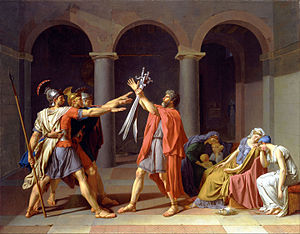
This is the Oath of the Horatii painted by
Jacques-Louis David in 1784. It is a
large oil on canvas painting 326 cm x 420cm that currently resides in the
Louvre, Paris. This painting depicts a
scene from Roman legend of the war between Rome and Alba Longa. It is said that instead of a full-fledged war
an agreement was made that three brothers from the Roman family, the Horatii,
would fight three brothers from the Alba Longa family, the Curiatii to the
death. This personal sacrifice of life
was a symbol of man’s sacrifice for the greater good and saving their city from
the sorrows of large scale war. The
source this legend is said to be built the story of David’s Oath in the first
book of Livy (Sections 24-6).

This focal
point highlights the story of three sons sacrifice to in essence save
everything. The focus on the swords brings
in all of the elements of the painting, Women crying for the potential loss of
life, the father presenting the swords to his sons, the architecture in the background,
and finally the viewer, brings the moment to the viewer.
List of
style choices:
-
Highlight (bright)
figures in the foreground
-
Overlapping
Ranks
-
Dull colors
to show importance of story
-
Symbolism of
the number 3
-
No brushstrokes
to attention isn’t called to artist just the subject of the painting
-
Man are depicted
with straight lines where the women are curvilinear
-
Woman are
emotional and men are strong for their strong sense of duty
-
A depiction of
a morally uplifting story
Sources:
http://www.perseus.tufts.edu/hopper/text?doc=Perseus%3Atext%3A1999.02.0147%3Abook%3D24%3Achapter%3D6
http://www.jstor.org.lib-ezproxy.tamu.edu:2048/stable/3047876
Jacques-Louis David: Art in Metamorphosis by Dorothy Johnson
Transformations in Late Eighteenth Century Art By Robert Rosenblum:
Source finding
help from:
No comments:
Post a Comment